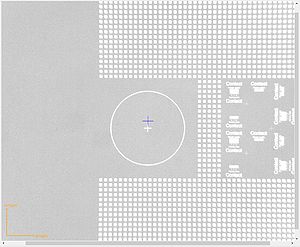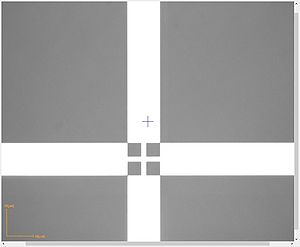Specific Process Knowledge/Lithography/Aligners/Aligner: Maskless 03 processing: Difference between revisions
| Line 288: | Line 288: | ||
|-style="background:silver; color:black" | |-style="background:silver; color:black" | ||
!colspan="2" align="center"| | !colspan="2" align="center"| | ||
! | !Median [nm] | ||
! | !Average [nm] | ||
|- | |- | ||
Revision as of 08:33, 16 April 2020
Feedback to this page: click here
Exposure technology
Aligner: Maskless 03 is not a direct writer. In the maskless aligner, the exposure light is passed through a spatial light modulator, much like in a video projector, and projected onto the substrate, thus exposing an area of the design at a time. The substrate is exposed by scanning the exposure field across the substrate in a succession of stripes.
The light source is a laser diode (array) with a wavelength of 405nm (8W). The spacial light modulator is a digital micro-mirror device. The individual mirrors of the DMD are switched in order to represent the design, and the laser is flashed in order to yield the desired exposure dose. This image is projected onto the substrate through a lens(system). The projected image yields a pixel size of 500nm X 500nm at wafer scale. The image is scanned across the substrate, in order to expose the entire design, each stripe overlapping (2 or 5 times depending on exposure mode) in order to minimize uniformity effects and stitching errors. The address grid size is 250nm or 100nm for Fast or Quality exposure mode, respectively.
The writing head of the Aligner: Maskless 03 moves only in the z-direction. Using a pneumatic focusing system, the maskless aligner is able to do real-time autofocus. The defocus process parameter is used to compensate for offsets between the autofocus mechanism and the focal point of the exposure light, and simultaneously optimize print quality in different resists and varying thicknesses. The stage of the Aligner: Maskless 03 moves only in x and y. It has no theta-axis. All rotation during alignment is thus accomplished by transformation of the input design.
Process Parameters
The lithographic result of exposure on Aligner: Maskless 03 depends on a lot of factors, including the dose and defocus parameters, and the exposure mode used. The optimal dose and defocus depend on the type and thickness of the resist, and the optical properties of the substrate (e.g. reflective/absorbing/transparent). All of these factors influence the obtainable resolution, as well as the writing speed.
The correct way to determine the best dose-defocus settings is to generate a so-called Bossung plot (known from projection lithography), which plots the printed linewidth as a function of dose and defocus. From this, the most stable region of parameter space is chosen, i.e. the region where the linewidth changes the least when dose and defocus changes. Any deviation from the design linewidth may be corrected using the CD bias parameter. This typically involves SEM imaging of resist cross-sections, and quickly becomes time consuming. However, in most cases, inspection of a dose-defocus matrix (easily generated using the series exposure function) in an optical microscope will get you most of the way.
Data represent dose-defocus tests on Si using optical autofocus unless otherwise stated
| Thickness | Exposure mode | Dose | Defoc | Resolution | Comments | |
|---|---|---|---|---|---|---|
| AZ 5214E | 1.5 µm | Fast | 69-72 mJ/cm2 (Taran Mar 2020) | 0 (Jehem Feb 2020) | 2 µm (due to stitching) | Dev: SP60s |
| Quality | 69 mJ/cm2 (Taran Mar 2020) | 0 (Jehem Feb 2020) | 1.25 µm | Dev: SP60s | ||
| AZ MiR 701 | 1.5 µm | Fast | 300 mJ/cm2 (Jehem Feb 2020) | 0 (Jehem Feb 2020) | 2 µm (due to stitching) | PEB: 60s@110°C, Dev: SP60s |
| Quality | 180-200 mJ/cm2 (Taran Mar 2020) | 0-1 (Jehem Mar 2020) | 1 µm | PEB: 60s@110°C, Dev: SP60s | ||
| AZ 5214E image reversal | 2.2 µm | Fast | 43 mJ/cm2 (Taran Mar 2020) | 0 (Jehem Feb 2020) | >2 µm (a lot of stitching) | Reversal bake: 120s@110°C, Flood exposure: 200mJ/cm2, Dev: SP60s |
| Quality | 43 mJ/cm2 (Taran Mar 2020) | 0 (Jehem Feb 2020) | 2 µm (due to stitching) | Reversal bake: 120s@110°C, Flood exposure: 200mJ/cm2, Dev: SP60s |
AZ nLOF 2020 has also been tested. It seems to work even at 405nm, but the dose is so high (>10000) that exposure would be slower than Aligner: Maskless 02.
Exposure mode
Aligner: Maskless 03 offers two exposure modes. The exposure mode is selected during design conversion.
Quality mode is used for optimal resolution, best overlay accuracy, and minimum stripe stitching effects.
In the high quality mode, an area of the pattern is exposed by 5 stripes, each 500µm wide and exposing a fifth of the dose. At the same time, sub-pixel interpolation is applied, yielding an address grid size of 100nm.
Fast mode is used for maximum exposure speed.
In the fast mode, each area of the pattern is exposed by 2 stripes only. This reduces the exposure time by 60%, but also increases the size of the address grid in the X-direction to 250nm. This means that alignment will be less accurate in fast mode. Due to less averaging of non-uniformities, stitching effects will be more prominent in this mode.
Writing speed
According to specs, the writing speed of Aligner: Maskless 03 is 1100mm2/min in fast mode. Using the high quality exposure mode cuts this speed in half, to approximately 550mm2/min. The writing speed for a 100x100mm2 area measured during installation of the machine (acceptance test) was ~1200mm2/min.
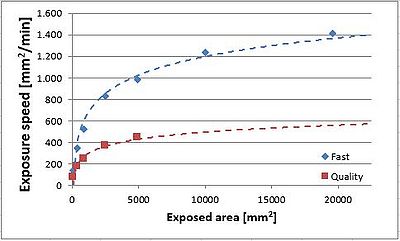
Speed vs. area:
During exposure of a stripe the stage moves at a constant speed. Each stripe thus includes a certain movement overhead for acceleration and deceleration. As the stripes get shorter, this overhead becomes more significant, and the normal writing speed is no longer achieved. For samples slightly smaller than a 4" wafer, the writing speed of Aligner: Maskless 03 drops below the specified 1100mm2/min.
When the exposure is started on the maskless aligner, the software starts converting the design to the data needed for the exposure. When sufficient data has been generated, the hardware starts exposing the sample while more data is being generated. This simultaneous data conversion and exposure is called Online conversion. Once a design has been converted (exposed) the data may be reused for repeated exposures (Offline conversion). However, the converted data can only be reused if no alignment is needed, including flat alignment ("Expose with substrate angle"). Due to the powerful, separate conversion PC on Aligner: Maskless 03, offline exposure is only very slightly faster than online.
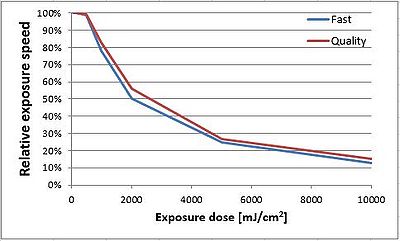
Speed vs. dose:
The writing speed of Aligner: Maskless 03 remains constant up to a dose of 500mJ/cm2. After this point, the writing speed decreases with increasing dose. The writing speed is 50% at a dose around 2000mJ/cm2.
Acceptance test
Acceptance criteria on a 100 X 100 mm2 area: Width of smallest resolved line 1000±120 nm (quality), alignment error 500 nm (quality), writing speed 1100 mm2/min (fast).
The acceptance test also included a verification of back side alignment (better than 1 µm), as well as a test of the conversion speed (less than 15 minutes for a dense design of circles).
Exposed on mask blank, transferred via wet chrome etch, and measured at Heidelberg (FAT), or exposed and inspected at DTU (SAT)
| Width of smallest resolved line [nm] | Alignment error (TSA) [nm] | Exposure speed [mm2/min] | ||
|---|---|---|---|---|
| FAT December 2019 | X | 985±72 | 427 | 1269 |
| Y | 953±47 | 362 | ||
| SAT February 2020 | ≤1000 | ≤500 | 1212 | |
Features
Substrate centring and flat alignment
During substrate detection, the sample is scanned along the X- and Y-axes, as well as diagonally. From these measurements, the size (diameter) of the substrate is calculated, as well as the stage position matching the center of the substrate. This stage position will be the default origin for the subsequent exposure.
At the end of substrate detection, the sample is scanned twice along the bottom edge (flat), in order to determine the substrate rotation. This angle will be presented in the exposure panel along with the option to expose the design rotated in order to compensate for this angle, i.e. aligned to the flat/edge of the substrate.
Result of using "Expose with substrate angle":
- Rotation: 0.05±0.2°
- Centering:
- X -125±25µm
- Y 104±36µm
Jehem Feb 2020, average of 3 4" wafers.
Result of loading the same substrate 10 times without removing it from the stage:
| Average | Range | |
|---|---|---|
| Jehem Feb 2020 | 3.6 mRad | ±1.4 mRad
±0.08° |
As expected from Aligner Maskless 01 and 02, the accuracy of flat alignment is ±0.1°, and the substrate centering is within a couple of hundred µm.
Large defocus range
The standard range for the defocus parameter is -10 to 10, but a special feature allows to extend this range to -25 to 25, which may be useful when exposing thick resist. The large defocus range feature is activated in the resist template, and can only be accessed by asking staff to set up a custom resist template.
Alignment
This section is under construction 
Top Side Alignment
Overlay accuracy (spec): 0.5µm
Camera field of view (W x H):
High Res 190 µm x 140 µm
Low Res 640 µm x 480 µm
Overview 12 mm x 9 mm
Accessible stage coordinates:
High/Low Res X = ±??mm; Y = ±??mm
Overview X = ±??mm; Y = +10?mm to -??mm
To be sure the Overview camera can be used to locate the first alignment mark, it is advised to use a mark in the bottom left portion (3rd quadrant) of the design as mark 1.
Back Side Alignment
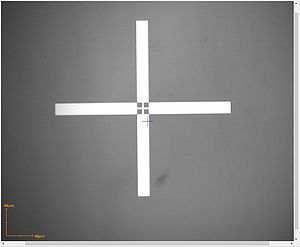
Overlay accuracy (spec): 1.0µm
BSA windows: along the X and Y axes, 10mm x 46mm, starting 14.5mm from the center.
Camera field of view (W x H): 640µm x 480µm
The alignment marks must be placed within the BSA windows. The Overview camera only shows the top side of the substrate, and cannot be used to locate the BSA marks.
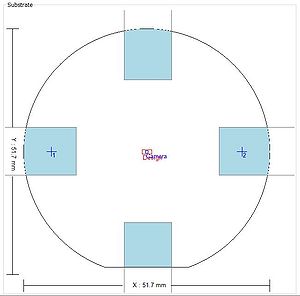
|
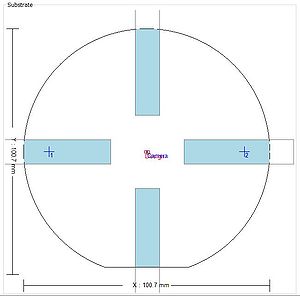
|

|
| BSA marks positionned at x = ±20mm on a 2" wafer | BSA marks positionned at x = ±40mm on a 4" wafer | BSA marks positionned at x = ±50mm on a 6" wafer |
Advanced Field alignment (TSA)
Overlay accuracy (spec): 0.25µm (5x5mm2 area)
Shift, rotation, scaling, and shearing is determined and set by global alignment marks. The shift is corrected by automatic alignment to one mark in each field (chip).
Advanced field alignment test:
| Median [nm] | Average [nm] | ||
|---|---|---|---|
| 25 fields
High res camera (Jehem Feb 2020) |
X | 100±55 | 106±55 |
| Y | 100±56 | 104±56 | |

